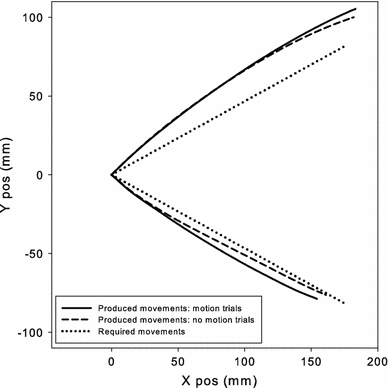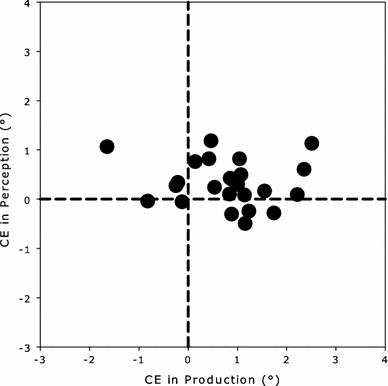On interference effects in concurrent perception and action
- PMID: 19214564
- PMCID: PMC2808521
- DOI: 10.1007/s00426-009-0226-2
On interference effects in concurrent perception and action
Abstract
Recent studies have reported repulsion effects between the perception of visual motion and the concurrent production of hand movements. Two models, based on the notions of common coding and internal forward modeling, have been proposed to account for these phenomena. They predict that the size of the effects in perception and action should be monotonically related and vary with the amount of similarity between what is produced and perceived. These predictions were tested in four experiments in which participants were asked to make hand movements in certain directions while simultaneously encoding the direction of an independent stimulus motion. As expected, perceived directions were repelled by produced directions, and produced directions were repelled by perceived directions. However, contrary to the models, the size of the effects in perception and action did not covary, nor did they depend (as predicted) on the amount of perception-action similarity. We propose that such interactions are mediated by the activation of categorical representations.
Figures









Similar articles
-
Assimilation and contrast: the two sides of specific interference between action and perception.Psychol Res. 2012 Mar;76(2):171-82. doi: 10.1007/s00426-011-0338-3. Epub 2011 May 10. Psychol Res. 2012. PMID: 21556808 Review.
-
Acting while perceiving: assimilation precedes contrast.Psychol Res. 2009 Jan;73(1):3-13. doi: 10.1007/s00426-008-0146-6. Epub 2008 Mar 26. Psychol Res. 2009. PMID: 18365250 Free PMC article. Review.
-
Seeing while moving: measuring the online influence of action on perception.Q J Exp Psychol (Hove). 2007 Aug;60(8):1063-71. doi: 10.1080/17470210701288722. Q J Exp Psychol (Hove). 2007. PMID: 17654391
-
What part of an action interferes with ongoing perception?Acta Psychol (Amst). 2010 Jul;134(3):403-9. doi: 10.1016/j.actpsy.2010.04.003. Epub 2010 May 15. Acta Psychol (Amst). 2010. PMID: 20472224
-
On-line vs. off-line utilization of peripheral visual afferent information to ensure spatial accuracy of goal-directed movements.Exp Brain Res. 2004 Sep;158(1):75-85. doi: 10.1007/s00221-004-1874-5. Epub 2004 Mar 17. Exp Brain Res. 2004. PMID: 15029468
Cited by
-
Observing human movements helps decoding environmental forces.Exp Brain Res. 2011 Nov;215(1):53-63. doi: 10.1007/s00221-011-2871-0. Epub 2011 Sep 27. Exp Brain Res. 2011. PMID: 21947172
-
Are you approaching me? Motor execution influences perceived action orientation.PLoS One. 2012;7(5):e37514. doi: 10.1371/journal.pone.0037514. Epub 2012 May 18. PLoS One. 2012. PMID: 22624042 Free PMC article.
-
Assimilation and contrast: the two sides of specific interference between action and perception.Psychol Res. 2012 Mar;76(2):171-82. doi: 10.1007/s00426-011-0338-3. Epub 2011 May 10. Psychol Res. 2012. PMID: 21556808 Review.
-
Response actions influence the categorization of directions in auditory space.Front Psychol. 2015 Aug 7;6:1163. doi: 10.3389/fpsyg.2015.01163. eCollection 2015. Front Psychol. 2015. PMID: 26300837 Free PMC article.
-
Investigating ideomotor cognition with motorvisual priming paradigms: key findings, methodological challenges, and future directions.Front Psychol. 2012 Nov 23;3:519. doi: 10.3389/fpsyg.2012.00519. eCollection 2012. Front Psychol. 2012. PMID: 23189067 Free PMC article.
References
-
- Braine LG. A new slant on orientation perception. The American Psychologist. 1978;33(1):10–22. doi: 10.1037/0003-066X.33.1.10. - DOI
MeSH terms
LinkOut - more resources
Full Text Sources
Research Materials

